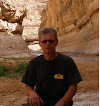.
Welwitschia is an unusual ancient plant that grows in the desert of South Namibia and in Southern Angola. And it looks like a strange pile of dead leaves withered from the ends.
The plant consists of a low stem and only of two leaves, the ends of the leaves are broken and dead . It is a “gymnosperm” and is adapted to live in the desert and having only the root and leaves. The plant can live up to 1,500 years, the leaves grow throughout the life of the plant, but they decay from the ends and their length does not exceed 4-5 meters.
It is said that in 1860, when the Austrian botanist Friedrich Welwitsch - while travelling in South Africa- discovered that plant - he fell to his knees and didn´t dare to touch it for a long time.
Welwitschia blooms only once in its lifetime.

Welwitschia is adapted to extreme desert conditions, it does not depend on rain water, but can acquire water from fog clouds coming from the ocean.












